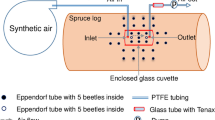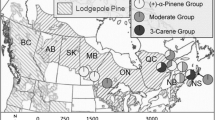Abstract
Bark beetle infested pines are an ephemeral habitat utilized by a diverse assemblage of insects. Although many bark beetle insect associates have little or no measurable impact on bark beetle brood production, some reduce brood production by either competing with brood for the limited phloem tissue or by feeding on brood. Several studies have observed synchrony between the colonization of hosts by bark beetles and the arrival of insect associates. Some insect associates mediate synchrony with bark beetle mass attacks with kairomonal responses to bark beetle aggregation pheromones. The objectives of this study were to document the community of Coleoptera associated with the southern Ips (Ips avulsus, Ips calligraphus and Ips grandicollis) and to test the hypothesis that synchrony of insect associates with the southern Ips is mediated by kairomonal responses to aggregation pheromones. A large community of Coleoptera (109 species) was recorded from traps baited with southern Ips pheromones. A significant treatment effect was observed for the guilds of meristem feeders, natural enemies and woodborers. The southern Ips pheromone ipsenol was broadly attractive to meristem feeders, natural enemies and woodborers and in general blends were more attractive than individual compounds. These results demonstrate that a diverse community of Coleoptera is associated with the southern Ips and that several members of this community facilitate synchrony with kairomonal responses to southern Ips aggregation pheromones.



Similar content being viewed by others
References
Allison JD, Borden JH, McIntosh RL, de Groot P, Gries R (2001) Kairomonal response by four Monochamus species (Coleoptera: Cerambycidae) to bark beetle pheromones. J Chem Ecol 27:633–646
Allison JD, Morewood WD, Borden JH, Hein KE, Wilson IM (2003) Differential bio-activity of Ips and Dendroctonus pheromone components for Monochamus clamator and M. scutellatus (Coleoptera: Cerambycidae). Environ Entomol 32:23–30
Allison JD, Borden JH, Seybold SJ (2004) A review of the chemical ecology of the Cerambycidae (Coleoptera). Chemoecology 14:123–150
Allison JO, Mckenney JL, Miller DR, Gimmel ML (2012) Role of ipsdienol, ipsenol, and cis-Verbenol in chemical ecology of Ips avulsus, Ips calligraphus, and Ips grandicollis (Coleoptera: Curculionidae: Scolytinae). J Econ Entomol 105:923–929
Amman GD (1984) Mountain pine beetle (Coleoptera: Scolytide) mortality in three types of infestations. Environ Entomol 13:184–191
Ascoli-Christensen A, Salom SM, Payne TL (1993) Olfactory receptor cell responses of Ips grandicollis (Eichhoff) (Coleoptera: Scolytidae) to intra- and interspecific behavioral chemicals. J Chem Ecol 19:699–712
Aukema BH, Dahlsten DL, Raffa KF (2000) Exploiting behavioral disparities among predators and prey to selectively target pests: maximizing bark beetle: predator removal during semiochemically based trap-out. Environ Entomol 29:651–660
Barron JR (1971) A revision of the trogossitidae of America north of Mexico (Coleoptera: Cleroidea). Mem Entomol Soc Can 75:1–143
Benjamini Y, Hochberg Y (1995) Controlling the false discovery rate: a practical and powerful approach to multiple testing. J Roy Stat Soc Ser B 57:289–300
Billings RF, Cameron RS (1984) Kairomonal responses of Coleoptera, Monochamus titillator (Cerambycidae), Thanasimus dubius (Cleridae), and Temnochila virescens (Trogossitidae), to behavioral chemicals of the southern pine bark beetles (Coleoptera: Scolytidae). Environ Entomol 13:1542–1548
Bowers WW, Borden JH (1992) Attraction of Lasconotus intricatus Kraus (Coleoptera, Colydiidae) to the aggregation pheromone of the 4-eyed spruce bark beetle, Polygraphus rufipennis (Kirby) (Coleoptera, Scolytidae). Can Entomol 124:1–5
Camors FB, Payne TL Jr (1973) Sequence of arrival of entomophagous insects to trees infested with the southern pine beetle. Environ Entomol 2:267–270
De Groot P, DeBarr GL (2000) Response of cone and twig beetles (Coleoptera: Scolytidae) and a predator (Coleoptera: Cleridae) to pityol, conophthorin, and verbenone. Can Entomol 132:843–851
Dixon WN, Payne TL (1979) Sequence of arrival and spatial distribution of entomophagous and associate insects on southern pine beetle-infested trees. Tex A&M Exp Stn MP—1432
Dixon WN, Payne TL (1980) Attraction of entomophagous and associate insects of the southern pine-beetle to beetle-produced and host tree-produced volatiles (Coleoptera, Scolytidae). J Ga Entomol Soc 15:378–389
Erbilgin N, Raffa KF (2000) Opposing effects of host monoterpenes on responses by two sympatric species of bark beetles to their aggregation pheromones. J Chem Ecol 26:2527–2548
Garcia LV (2004) Escaping the Bonferonni iron claw in ecological studies. Oikos 105:657–663
Hager BJ, Teale SA (1994) Repeatability of female response to ipsdienol enantiomeric mixtures by pine engraver, Ips pini (Coleoptera: Scolytidae). J Chem Ecol 20:2611–2622
Hager BJ, Teale SA (1996) The genetic control of pheromone production and response in the pine engraver beetle Ips pini. Heredity 77:100–107
Haynes KF, Yeargan KV (1999) Exploitation of intraspecific communication systems: illicit signalers and receivers. Ann Entomol Soc Am 92:960–970
Hughes PR (1974) Myrcene: a precursor of pheromones in Ips beetles. J Insect Physiol 20:1271–1275
Kulhavy DL, Goyer RA, Bing JW, Riley MA (1989) Ips spp. natural enemy relationships in the Gulf coastal states. In: Kulhavy DL, Miller MC (eds) Potential for biological control of Dendroctonus and Ips bark beetles. University of Texas Press, Austin
Leavengood JM, Jr (2008) The checkered beetles (Coleoptera: Cleridae) of Florida. Unpublished masters thesis, University of Florida, p 206
Lingafelter SW (2007) Illustrated key to the longhorned woodboring beetles of the eastern United States. Coleopterists Society Special Publication No. 3. North Potomac, Maryland, p 206
Linit MJ, Stephen FM (1983) Parasite and predator component of within-tree southern pine beetle mortality. Can Entomol 115:679–688
McCune B, Grace JB, Urban DL (2002) Analysis of ecological communities. MjM Software Design, Gleneden Beach, pp 188–197
Miller DR (2007) Limonene: Attractant kairomone for white pine cone beetles (Coleoptera: Scolytidae) in an eastern white pine seed orchard in western North Carolina. J Econ Entomol 100:815–822
Miller DR, Asaro C (2005) Ipsenol and ipsdienol attract Monochamus titillator (Coleoptera: Scolytidae) and associated large pine woodborers in southeastern United States. J Econ Entomol 98:2033–2040
Miller DR, Allison JD (2011) Variation in enantiospecific attraction of Ips avulsus (Coleoptera: Curculionidae) to the pheromone ipsdienol in Georgia. J Econ Entomol 104:895–900
Miller DR, Asaro C, Crowe CM, Duerr DA (2011) Bark beetle pheromones and pine volatiles: attractant kairomone lure blend for longhorn beetles (Cerambycidae) in pine stands of the southeastern United States. J Econ Entomol 104:1245–1257
Miller MC (1984) Effect of exclusion of insect associates on Ips calligraphus (Germ.) (Coleoptera, Scolytidae) brood emergence. Z Angew Entomol 97:298–304
Moser JE, Thatcher RC, Pickard LS (1971) Relative abundance of southern pine beetle associates in East Texas. Ann Entomol Soc Am 64:73–77
Nelson GH (1975) A revision of the genus Dicerca in North America (Coleoptera: Buprestidae). Ent Arb Mus Frey 26:87–180
Otte D (1974) Effects and functions in the evolution of signaling systems. Annu Rev Ecol Syst 5:385–417
Overgaard NA (1968) Insects associated with the southern pine beetle in East Texas, Louisiana and Mississippi. J Econ Entomol 61:1197–1201
Payne TL (1989) Olfactory basis for insect enemies of allied species. In: Kulhavy DL, Miller MC (eds) Potential for biological control of Dendroctonus and Ips bark beetles. University of Texas Press, Austin
Payne TL, Dickens JC, Richerson JV (1984) Insect predator-prey coevolution via enantiomeric specificity in a kairomone-pheromone system. J Chem Ecol 10:487–492
Price TS, Doggett C, Pye JM, Smith B (1998) A history of southern pine beetle outbreaks in the southeastern United States. Ga For Comm, Atlanta
Raffa KF (1991) Temporal and spatial disparities among bark beetles, predators and associates responding to synthetic bark beetle pheromones: Ips pini (Coleoptera: Scolytidae) in Wisconsin. Environ Entomol 20:1665–1679
Raffa KF (2001) Mixed messages across multiple trophic levels: the ecology of bark beetle communication systems. Chemoecology 11:49–65
Raffa KF, Klepzig KD (1989) Chiral escape of bark beetles from predators responding to a bark beetle pheromone. Oecologia 80:566–569
Reeve JD (1997) Predation and bark beetle dynamics. Oecologia 112:48–54
Reeve JD, Turchin P (2002) Evidence for predator-prey cycles in a bark beetle. In: Berryman AA (ed) Population cycles: evidence for trophic interactions. Oxford University Press, New York
Reeve JD, Strom BL, Rieske LK, Ayres BD, Costa A (2009) Geographic variation in prey preference in bark beetle predators. Ecol Entomol 34:183–192
Renwick JAA, Vité JP (1972) Pheromones and host volatiles that govern aggregation of the six-spined engraver beetle, Ips calligraphus. J Insect Physiol 18:1215–1219
Riley MA, Goyer RA (1986) Impact of beneficial insects on Ips spp. (Coleoptera: Scolytidae) bark beetles in felled loblolly and slash pines in Louisiana. Environ Entomol 15:1220–1224
Schroeder LM, Weslien J (1994) Interactions between the phloem-feeding species Tomicus piniperda (Col.: Scolytidae) and Acanthocinus aedilis (Col.: Cerambycidae) and the predator Thanasimus formicarius (Col.: Cleridae) with special reference to brood production. Entomophaga 39:149–157
Shepherd WP, Goyer RA (2003) Seasonal abundance, arrival and emergence patterns of predaceous hister beetles (Coleoptera: Histeridae) associated with Ips engraver beetles (Coleoptera: Scolytidae) in Louisiana. J Entomol Sci 38:612–620
Shepherd WP, Sullivan BT, Goyer RA, Klepzig KD (2005) Electrophysiological and olfactometer responses of two histerid predators to three pine bark beetle pheromones. J Chem Ecol 31:1101–1110
Smith MT, Busch GR, Payne TL, Dickens JC (1988) Antennal olfactory responsiveness of three sympatric Ips species [Ips avulsus (Eichhoff), Ips calligraphus (Germar), Ips grandicollis (Eichhoff)], to intra- and interspecific behavioral chemicals. J Chem Ecol 14:1289–1304
Smith MT, Salom SM, Payne TL (1993) The southern pine bark beetle guild: an historical review of the research on the semiochemical-based communication system of the five principle species. Virginia Agricultural Experiment Station, Bulletin No. 93–4. Blacksburg, VA. p 106
Steed BE, Wagner MR (2008) Seasonal pheromone response by Ips pini in northern Arizona and western Montana, USA. Agr For Entomol 10:189–203
Stephan KH (1989) The Bothrideridae and Colydiidae of America north of Mexico (Coleoptera: Clavicornia and Heteromera). Occasional Papers of the Florida State Collection of Arthropods No. 6. Florida Department of Agriculture and Consumer Services, Gainesville, Florida. xii + 65 pp
Teale SA, Hager BJ, Webster FX (1994) Pheromone-based assortative mating in a bark beetle. Anim Behav 48:569–578
Triplehorn CA (1990) Review of the genus Corticeus (Coleoptera: Tenebrionidae) of America north of Mexico. Ann Entomol Soc Am 83:287–306
Turchin P, Taylor AD, Reeve JD (1999) Dynamical role of predators in population cycles of a forest insect: an experimental test. Science 285:1068–1071
Turnbow RH Jr, Franklin RT (1981) Platysoma (Cylistix) cylindrica Payk.: response to ipsenol. J Ga Entomol Soc 16:171–175
Vité JP, Williamson DL (1970) Thanasimus dubius: prey perception. J Insect Physiol 16:233–239
Vité JP, Renwick JAA (1971) Population aggregating pheromone in the bark beetle, Ips grandicollis. J Insect Physiol 17:1699–1704
Vité JP, Bakke A, Renwick JAA (1972) Pheromones in Ips (Coleoptera: Scolytidae): occurrence and production. Can Entomol 104:1967–1975
Wellso SG, Manley GV (2007) A revision of the Chrysobothris femorata (Olivier, 1790) species group from North America, north of Mexico (Coleoptera: Buprestidae). Zootaxa 1652:1–26
Zhang QH, Erbilgin N, Seybold SJ (2008) GC-EAD responses to semiochemicals by eight beetles in the subcortical community associated with Monterey pine trees in coastal California: similarities and disparities across three trophic levels. Chemoecology 18:243–254
Acknowledgments
We thank C. M. Crowe for field assistance; Dearl Sanders of the Bob R. Jones-Idlewild Research Station, LSU AgCenter and the staff of the Oconee National Forest for assistance and access to field sites and Alexey K. Tishechkin (Santa Barbara Museum of Natural History, Santa Barbara, CA) for help with Histeridae identification.
Author information
Authors and Affiliations
Corresponding author
Additional information
The use of trade names and identification of firms or corporations does not constitute an official endorsement or approval by the United States Government of any product or service to the exclusion of others that may be suitable. Funding for this research was provided by the USDA Forest Service. The USDA is an equal opportunity provider and employer.
Rights and permissions
About this article
Cite this article
Allison, J.D., McKenney, J.L., Miller, D.R. et al. Kairomonal Responses of Natural Enemies and Associates of the Southern Ips (Coleoptera: Curculionidae: Scolytinae) to Ipsdienol, Ipsenol and Cis-Verbenol. J Insect Behav 26, 321–335 (2013). https://doi.org/10.1007/s10905-012-9349-1
Revised:
Accepted:
Published:
Issue Date:
DOI: https://doi.org/10.1007/s10905-012-9349-1




